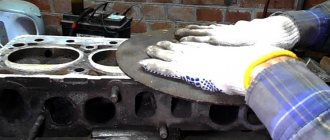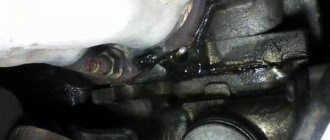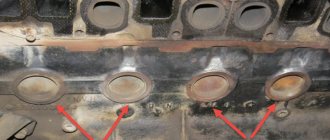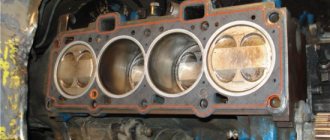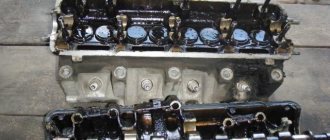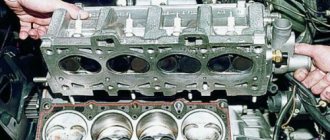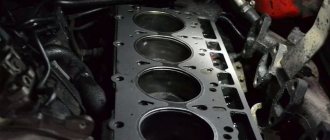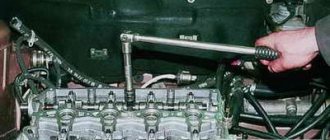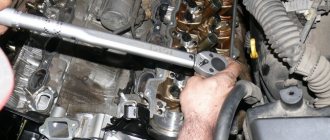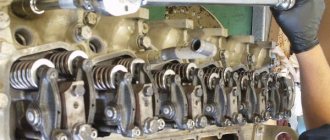The cylinder block is one of the main parts of the engine, which directly affects the quality of its operation. Violation of the normal functioning of this motor unit mainly occurs due to deformation of the head, which is the cover covering the cylinders. Any unevenness or curvature of this part prevents a normal fit to the block and causes problems in the operation of the engine. Grinding the cylinder head, which is carried out during a major engine overhaul, helps eliminate deformation.
DIY cylinder head grinding
The engine is one of the main components of a car, and the cylinder head is the heart of this component. When repairing, sanding is often necessary. We'll talk about grinding methods, reasons, preparatory work and the process.
Everything in the cylinder head is interconnected; if one part fails, it pulls the rest along with it. Thus, it is worth looking after the engine as best as possible and carrying out repairs on time. As for grinding, it should not be carried out every time there is a breakdown, but only if irregularities appear.
When is cylinder head grinding necessary?
Experts advise checking and grinding the cylinder head when performing any complex work on engine components associated with removing the block. Direct indications for performing the process are.
- Violation of the geometry of the part due to overheating.
- After welding work. If there were defects in the head that were eliminated by welding, grinding is a mandatory step after completion.
REFERENCE. Grinding is also carried out in order to increase engine power when fine tuning it. Reducing the head height allows for a higher compression ratio.
Deformation of the cylinder head leads to a loose fit of the gasket, and this in turn causes problems in engine operation:
- reduction in engine power;
- leakage of technical fluids;
- difficulty starting the engine;
- motor overheating.
If such problems occur, unscheduled grinding of the cylinder head is required.
Main Reasons for Grinding
The first and main condition for starting grinding is the uneven installation of the cylinder head gasket and its subsequent burnout. The reasons for this appearance may be overheating of the engine, the ingress of small mechanical parts, or water, which, if detonated, can damage the gasket.
The gasket itself is not so simple; it consists of several layers and a frame; it is made from perforated sheet steel. The main purpose is to seal the joints of two parts. Boiling of the engine, bubbles in the cooling system, change in oil color are the first indicators that the cylinder head gasket has become unusable.
Engine tuning is often considered the second reason for grinding. A sign of this is a decrease in engine power when you press the accelerator pedal, or simply the engine stops pulling. I would like to say right away that the process is not easy and will require the expenditure of both time and money.
Cylinder head grinding options
Cylinder head grinding is a delicate and time-consuming process. The best grinding is carried out in service centers at service stations, but as an option you can do it at home. Special instruments and devices are very expensive. If we take remote settlements, then it is not always possible to find a simple service station.
Basically, it can be divided into manual and mechanical grinding. Mechanical work is performed on special machines. Manual grinding of the cylinder head, although a longer procedure, requires a lot of patience and perseverance.
Brief summary
“To drive crooked nails, you need a crooked hammer,” as the great foreman Crocodile Gena and his assistant Cheburashka said. In order to assemble a working motor from a crooked block head, no crooked tools have been invented. Therefore, if you want to assemble a reliable and durable motor, everything must comply with the manufacturer’s technical requirements, common sense and technical rationality.
Accordingly, the block head is definitely checked for deflection or flatness after removal and before installation, and if this flatness is broken, it needs to be restored. Restoration methods include milling or grinding on a specialized machine, and there are quite a few nuances in this work. You can, of course, master it yourself. Our people, thank God, are still strong-willed and fairly educated. But let the cake maker bake the pies, and let the shoemaker bake the boots. Therefore, contact the specialists, we will not only make for you a cylinder head suitable for further use, we will also use the example of this particular head to tell you what else you need to take into account and do so that the engine gets a reliable and long second life.
Preparation for sanding
For self-grinding, we will first need a set of feeler gauges and a metal ruler, with its help we will determine how strongly the cylinder head is bent and the degree of its unevenness. This is more of a method by eye, since only visually you can understand where and how much it costs to grind.
In addition to such unevenness, there may also be cracks and similar defects. This indicates that the engine overheated well and detonated. To identify such cracks, it is worth painting the cylinder head with slow-drying paint and wiping it off after a few minutes. Where the paint remains there will be a crack. It is advisable to use bright colors of paint. Unfortunately, only large cracks can be seen, but microcracks can only be seen with the help of special instruments.
In any case, no matter how bent the cylinder head is, the first thing you need to do before starting grinding is to check for both large and micro cracks.
Cylinder head grinding process
Removing the cylinder head is different for each car and there is no point in describing it. But you should understand that for this you will need to drain the oil and coolant, remove everything that is in the way, and stock up on new consumables.
Having removed the cylinder head, there are many questions about how much it costs to grind it, how it should be done and how to check the result. But everything is not as scary as it seems at first glance. It would be a good idea to check the valves during grinding and replace the valve seals. This is done so that after collection you do not have to rub in the burnt valve.
To start grinding, we need a sharpening stone or something similar to remove uneven layers evenly, accurately and without bending. Next, you should take a piece of glass the size of the cylinder head and some diesel fuel, since it has the property of not drying out quickly. After a little grinding, wipe the entire surface of the cylinder head with a thin layer of diesel fuel and apply clean and dry glass. It will immediately show where there is still a gap, and where the process was overdone.
It is worth knowing that when grinding the cylinder head, the movements with the grinding stone should be smooth in the form of a zero or a figure eight, but not straight and sharp. The result should be a mirror-like and completely flat surface, after which you can safely install and assemble the engine.
Step-by-step instruction
At service stations, cylinder head grinding is carried out mechanically on a special machine equipped with a grinding wheel. The result of the process depends on the professionalism of the master. If it exceeds the maximum allowable grinding layer specified in the engine manual, the part will have to be replaced.
Self-grinding of the cylinder head is carried out manually using sandpaper or a grindstone. It looks like this.
- The surface is treated without strong pressure, using movements in the form of a figure eight or zero. Sharp, straight movements are not allowed.
- After the first stage of grinding, take a piece of glass according to the size of the head and a small amount of diesel fuel. The surface is lubricated with diesel fuel and glass is applied. In places where too much layer is removed, a circle with liquid around the edges is formed. Where the insufficient layer has been removed, there is an air circle with fuel around the edge.
- Next, the glass is removed and the grinding process continues, taking into account the results of the control measurement.
- As soon as a perfectly smooth, mirror-like surface is obtained, the cylinder block can be assembled and installed in the engine.
IMPORTANT. An excessively removed layer of metal during grinding can permanently damage the part, so experts do not recommend performing the procedure yourself without certain skills.
A skillfully and carefully polished cylinder head, subject to proper operation and maintenance of the engine, will serve the car owner for tens of thousands of kilometers. Violation of the technology of the procedure will require it to be repeated after a short time.
Cylinder head grinding price
In many ways, the cost of such a procedure will depend on the chosen method and brand of engine. It is worth remembering that the more expensive the car and the larger the engine, the more expensive the procedure will be.
On a special machine, such a procedure will cost from 800 rubles per cylinder, manual work will be cheaper, about 500 rubles per cylinder. But it is worth remembering that if the work is not carried out by a professional, then when manually grinding the cylinder head, mistakes may be made. After a while you will need to repeat the procedure again.
Video of cylinder head grinding:
Source
What is a cylinder head?
The cylinder head is one of the key elements of the engine. It is located on the cylinder block, adhering to it as tightly as possible through the gasket. The gas distribution mechanism is located in the cylinder head. Also, the cylinder head housing partially houses the combustion chamber and passes through various components with technical fluids - lubricant and antifreeze.
Accordingly, in order for the cylinder head to fit tightly, it needs to be polished as efficiently as possible, and there should be no burrs, unevenness, or roughness on it.
Preparation for sanding
In addition to such unevenness, there may also be cracks and similar defects. This indicates that the engine overheated well and detonated. To identify such cracks, it is worth painting the cylinder head with slow-drying paint and wiping it off after a few minutes. Where the paint remains there will be a crack. It is advisable to use bright colors of paint. Unfortunately, only large cracks can be seen, but microcracks can only be seen with the help of special instruments.
In any case, no matter how bent the cylinder head is, the first thing you need to do before starting grinding is to check for both large and micro cracks.
In what cases is grinding the cylinder head required?
If the cylinder head does not fit tightly to the cylinder block, this leads to problems with the engine. Problems may appear:
These are fairly typical problems that indicate many engine problems, one of which may be a poor fit of the cylinder head and the need to grind it.
Most often, damage to the cylinder head is accompanied by damage to the gasket. If the gasket burns out, there will be a breakthrough of gases from the combustion chamber.
But not only when problems arise in engine operation, grinding the cylinder head is indicated. It is also necessary to carry out such work when performing any complex work on engine elements associated with the cylinder head. For example, cylinder head grinding is carried out when replacing the camshaft, gasket, eliminating defective liners, and so on. That is, whenever the cylinder head is removed, it is better to grind it before reinstalling it, thereby maximizing the mating plane of the cylinder head and cylinder block.
Also, cylinder head grinding can be carried out in order to increase engine power when it comes to fine tuning the engine. Reducing the height of the cylinder head allows you to increase the compression ratio.
Now let's touch on the intricacies of cylinder head repair
Many diesel cylinder heads use such a structural element as prechambers. Prechambers can be made of hardened steel. Prechambers can be made of powder sintered material, that is, practically metal ceramics. The hardness of such material is significantly higher than the hardness of the base metal of the head. Naturally, the prechambers and the plane of the block head have to be processed simultaneously. There is no way to remove the prechambers, process them, and then put them in place. In most cases, with rare exceptions, this is not possible.
This means we need to look for a technology that allows us to process both hard and soft metal at the same time. Most often this is grinding, ordinary flat grinding. When the axis of rotation of the grinding wheel is located parallel to the axis of movement of the table along with the product. This achieves a high speed of relative movement of the tool and low cutting forces.
It is important to select the correct grit and hardness of the bonding grinding wheel. And also the correct coolant (lubricating coolant). Why? Because the head can be made of aluminum alloy, the prechambers can be made of metal-ceramics, and the processing tool, the grinding wheel, must be some unique compromise that is capable of processing aluminum without material sticking to the wheel and enveloping, and at the same time capable of processing a hard prechamber without chipping , without burns and without other polishing defects. The task is not trivial, but a competent grinder can perform this task.
Specialized machines designed specifically for processing the plane of the block head and block offer a slightly different grinding method, when grinding with abrasive sectors, and the rotation axis of a set of abrasive sectors is perpendicular to the plane of movement of the product. This technology is personally somewhat less attractive to me, because the cutting speed is significantly lower than with classical flat grinding, the force exerted by the tool is higher, and the likelihood of grinding defects occurring is also somewhat greater than with a classic grinding machine. It turns out that the process is more capricious. Although, in some cases, we still use this technology.
Cylinder head gasket defects
No manufacturer can absolutely guarantee a long service life, since the formation of defects is influenced by many factors - engine condition, car model, driving style. Among the main defects, it is worth highlighting breakdown and burnout of the element in question. Why does the cylinder head gasket break, and what reasons can cause a burnout?
Cylinder head gasket failure and its causes
Almost all drivers do not notice a burst gasket until a serious breakdown makes itself felt. Parts of domestic cars are more susceptible to breakdown, since traditionally their quality is much lower than imported ones.
The need for repairs may be indicated by the presence of steam under the hood and noise when the engine is running, which was not there before. These signs of a broken cylinder head gasket indicate an external breakdown.
An internal breakdown is much more dangerous due to its invisibility. The problem can be detected by measuring compression in the cylinders, and drivers often perform such diagnostics when the engine is shaking.
Air bubbles in the radiator fluid and the presence of white steam in the exhaust pipe also indicate a problem. Oil may leak at the joints in the engine.
When it comes to causes, driving negligence is one of the most common. Let's look at them in more detail:
This is interesting: How to stop registering a car? Procedure for processing documents in 2022
How to grind a cylinder head
It is best to perform work on grinding the cylinder head at a service station that has the required equipment, as well as specialists familiar with such work. The grinding process itself goes as follows:
First of all, the specialist determines the plane of the cylinder head. To do this, you can use feelers and a regular steel ruler (if it has no defects, bends and is the same in thickness). The ruler is applied diagonally to the lower plane, and the feeler gauges are inserted into the gaps present between the cylinder head surface and the applied ruler;
Important: If the depth of damage exceeds the maximum permissible depth of removal of the cylinder head surface during grinding, the part will most likely have to be replaced. In rare cases, the problem can be solved by installing a thinner cylinder head gasket.
When performing work on grinding the cylinder head, the professionalism of the craftsman who performs the work is critical. The tightness of the system and the overall operation of the engine will depend on the quality of grinding. Therefore, it is not recommended to grind the cylinder head yourself without the proper equipment and skills.
( 130 votes, average: 4.48 out of 5)
Related Posts
Coolant (antifreeze, antifreeze) in the cylinder block
What is engine hydraulic hammer
Preparation for the process
The first step when performing work is to assess the condition of the cylinder head. Defects of the mating surface are carried out by placing the block on a perfectly flat surface using a steel ruler and a set of feeler gauges. A ruler that is free of defects and even in thickness is applied with its edge to the bottom plane diagonally. If a gap is visible between it and the surface of the block, a probe is inserted into it.
Gaps of up to 0.05 mm are considered acceptable and do not affect the operation of the cylinders. If the gap is greater than 0.1 mm, grinding is necessary. If there are significant gaps, the cylinder block must be replaced. Flat grinding is used only if the height of the head after the process is at least 135.60 mm.
IMPORTANT. If there is a burnout of the gasket, the surface deformation will be located exactly in that place or near it.
After detecting head deformation, the BC cylinders are inspected for cracks. A part with large cracks should not be sanded, since it will still not work correctly.
If no major defects are found, the block is checked for microcracks. In a service station, this is done using special equipment. In the garage, the test method is to paint the block and then clean it after 5-6 minutes. After being erased from the surface, the paint gets stuck into the cracks, and they are clearly visible. But this method can only identify external microcracks. The internal ones remain unnoticed. Before the grinding process, microcracks must be eliminated.
What's the result?
It is quite obvious that the further selection of the cylinder head gasket will also directly depend on the depth of grinding, not only in terms of materials of manufacture (for example, metal or reinforced paronite), but also in terms of thickness. This statement is also true if, after milling, there is a risk that the timing valves will be too long.
Qualified work on checking for leaks, repairing cracks, boring and grinding the cylinder head or cylinder head allows you to obtain a tested and fully functional part, which, after installation on the car, will be the key to the further proper operation of the internal combustion engine. For example, a professionally repaired and correctly installed head will last for more than tens of thousands of kilometers, provided that general recommendations during operation and timely maintenance and repair of the engine are followed.
How to independently determine that the cylinder head gasket has burned out. Recommendations for pulling the cylinder head after replacement. Which gasket is better to choose?
Grinding in valves: how to do it yourself. Why and when do you need to grind valves? How to grind valves, what grinding paste to choose. Recommendations.
Why do antifreeze or antifreeze enter the engine cylinders and what to do in such a situation. How to determine the presence of antifreeze in the cylinders yourself, repair methods.
What malfunctions are indicated by the emulsion on the oil dipstick and oil filler cap? Ways to independently determine the causes of this problem.
Repairing a cast iron or aluminum engine cylinder block using a liner. Types of sleeves and how the sleeves are inserted into the block. Tips and tricks.
When it is necessary to bore the engine crankshaft, what is crankshaft boring for? How the crankshaft is bored, features of the selection of liners.
What else is worth saying in this case?
Many cylinder heads of large industrial or truck engines have grooves for individual cylinder liner seals. In this case, if you have to touch the plane of the head, it is necessary to process this groove to the same exact depth. This is not an easy task. It can be performed with a universal Swiss tool Mira, it can be performed on a jig boring machine, and if highly qualified, it can also be performed on a conventional boring or vertical milling machine. All this is considered individually and the skill of the machine operator performing this operation is of great importance.
Here's another interesting point. Often, one to four camshafts rotate in the block head. If the plane of the block head was deformed by two or more tenths of a millimeter, this clearly indicates that the camshaft axis was deformed in the same way. The cylinder head is a single part, nothing has gone anywhere, and if the plane was deformed, then everything was deformed, including the camshaft supports.
If you restore flatness, this is one operation, highly precise, but still one. We went through it on a milling machine, okay, okay, we went through it three times, and in three passes we restored the plane. In this case, we have a head with an ideal flat mating surface and with a curved, bent, non-coaxial hole for the rotation of the camshaft.
Is it possible to shove a camshaft in there with some nasty force and make it rotate? Well, a trade union member with the help of a sledgehammer and some mother will definitely accomplish this task. The shaft may even try to rotate, but it will break very quickly. The supports of this very camshaft wear out, so if the head is already very expensive and there is nowhere to go, then after you have restored the flatness you will need to restore the alignment of the camshaft supports by horizontal boring or by tightening.
Since both of these operations—processing the plane and restoring the alignment of the camshaft supports—are labor-intensive and expensive and require high qualifications, in some cases, if the surface of the cylinder head is severely deformed, a reasonable solution is to replace it with a new one. It's nothing you can do. I'm a big NOT proponent of a disposable world, everything that can be fixed should be fixed, but there are situations when changing it makes more sense than trying to fix it.
Another point is the frequency of the block head surface after processing. And here the principle of not spoiling porridge with oil does not work. In some cases, especially if a metal head gasket is used to seal the gas joint between the block and the cylinder head, a perfectly ground surface will give a worse sealing result than a surface with the required roughness. Because the marks of the milling machine cutter left on the block head create local areas of compaction and deformation of the gasket and more reliably seal the gas joint complete with the metal gasket than if the block head were perfectly ground. This is such a common mistake - we polished it, the block head looks like a mirror, we assembled the engine, we rejoice, but, damn it, it leaks. And nothing can be done about it until we create the necessary roughness on the surface. The size of this roughness in Ra is usually indicated in reference literature.
I must note that more and more equipment manufacturers are trying to separate mechanics (Russian ones in particular) from this reference literature. Our planet does not need highly intelligent and highly qualified people. Therefore, now in the operating instructions and manuals they mainly write about how to set up the radio and how not to drink the operating fluids contained in the car. Previously, this was an instruction manual for operation and repair; now such a wonderful book is called a “user’s manual.” We are slowly degrading. That is, the hypothesis of human progress is not only unproven, but successfully refuted, and our whole life confirms this. Globalism, damn it. This is what we are fighting with.
How the cylinder head works
It is a complex and sophisticated part of petrol and diesel engines. Cylinder heads in automobile engines are made of light metals or aluminum alloys and cast. Cylinder head components differ depending on the type of fuel the engine runs on.
Cylinder head components, purpose.
The photo shows the operation of a 4-stroke gasoline engine.
The compression temperature reaches 300-400°C, and the pressure is 0.1-0.15 MPa, and at the moment of ignition - 2500°C and 3-4 MPa. The presence of complex components in the cylinder head leads to expensive repairs if the problem is not corrected in time: knocking of valves, wear of camshaft cams, destruction of the gasket.
DIY cylinder head grinding
A bent cylinder head is a fairly common occurrence. Therefore, car enthusiasts often wonder about cylinder head grinding. The cylinder head is an integral part of a car engine. It is in it that thermal processes occur. This is the cover that covers the cylinder, and is usually secured to the block with bolts or studs. In the cylinder head system, everything is interconnected, and therefore the failure of any part can lead to a malfunction of the entire system. To avoid such problems, you need to look after the engine and especially prevent it from overheating. In this case, it remains very important to monitor the operation of the cylinder head and carry out repairs in a timely manner. There is no need for grinding for prevention; it should be carried out only in case of unevenness.
Grinding methods
Grinding is one of the most popular cylinder head repair procedures. Of course, the most accurate and correct grinding is carried out in workshops, but this may not always be available. Special equipment is very expensive. A problem for this may also be the fact that in small villages there is not always a tire service. But you shouldn’t despair; you can grind the cylinder head yourself, thereby saving money on repairs. The process of grinding with your own hands, although not simple, is quite real.
Reasons for grinding
An important condition for grinding is the unsuitability of the cylinder head gasket, namely its burnout. Overheating of the car engine, ingress of a small amount of water or other mechanical particles and parts can cause this. The gasket itself is a complex part, which consists of several balls with a frame and made from perforated sheet steel. Its main purpose is to seal joints. Signs such as engine boiling, bubbles in the radiator, and gray oil may indicate a malfunction of this cylinder head gasket. In this case, the tightness of the gasket and cylinder block is broken, which leads to all these problems and consequences. The second reason for grinding the cylinder head is engine tuning. Also, a decrease in engine power is a sign of deformation of the cylinder head. This can be observed when pressing the accelerator, when the engine simply does not pull. Oil leakage can be easily noticed and will be displayed on the visual panel. Gasket failure can also be caused by low-quality fuel. If camshaft bearings are installed on the head, distortion of the cylinder head surface will quite possibly lead to them jamming.
Preparing for work
A set of feeler gauges and a metal ruler will help determine the degree of surface unevenness. The ruler is placed on the edge of the cylinder head, then passes the necessary feeler gauge, which determines irregularities and measures the gap. With the help of these devices, you can detect the deepest unevenness and the necessary degree of grinding to level it. Although this method is not 100% accurate, it is certainly possible to determine the quality necessary for normal operation. It should be noted that it is in the place where the gasket burns out that there will be the greatest curvature and unevenness. But that is not all. In addition, there may be defects such as cracks. There is a pretty good method for determining them. To do this, the cylinder head must be painted with slow-drying paint. Then wipe it off after a while. After this, you will be able to see the cracks, and if there are none, you can start sanding. True, it is impossible to determine microcracks or microcracks inside a block without a special device. In a specially designed device, the head body is heated, and then bubbles appear due to pressure, and thus cracks appear. To continue working you need to fix this problem.
Cylinder head grinding stone
Every experienced motorist who has ever dealt with repairing a cylinder head knows that this part is one of the most specific parts of a car. Actually, it is this node that our material is devoted to. Today we will tell you how to grind a cylinder head at home with a video, when it is needed and what needs to be taken into account before starting work.
Video “Grinding the cylinder head of a BMW car”
You can learn more about milling the cylinder head on a BMW from the video.
The issue of grinding the cylinder head arises when the gasket under the head has burned out. A sign of a burnt-out head gasket is that the engine boils, bubbles enter the radiator, and if the gasket burns out very badly, the coolant flows into the engine block, the oil becomes gray in color and increases in volume. Since our man does a lot of things with his own hands, not trusting workshops and saving money on repairs, I will explain how to polish the block head at home, yourself.
We removed the head from the engine, saw a burnt-out gasket, a lot of questions immediately arise: is the head straight, how much does it cost to grind the head, where are the heads ground, how to check the straightness of the head, etc. Everything here is simpler than we think!
To resolve these issues and not fool yourself, you just need to take it and grind the block head yourself at home without special machines. To grind the head in, you will need either a new cutting disc or a new sharpening stone. Usually, even severe unevenness in the heads can be leveled out in about twenty minutes, on your own.
In what cases is cylinder head grinding necessary?
It's no secret that all components of the cylinder head, without exception, are in close interaction with respect to each other. Accordingly, if one element fails, this can cause failure of other components or lead to a serious defect in the unit. For example, if holes appear in the cylinder head gasket, this may result in a leak of motor fluid. Accordingly, repair work will necessitate not only replacing the gasket itself, but also searching for the reasons why the gasket was broken.
In this case, the reason may even be a slight overheating of the engine or accidental ingress of moisture. However, the entire cylinder head in this case will undergo diagnostics. In practice, the gasket usually breaks through when there is a malfunction in the operation of the cylinder block, in particular, the interface between the cylinder head and the block itself. In such cases, milling of the cylinder head is necessary. Whether this can be done manually with your own hands and what kind of machine you will need, you will find out further.
A machine designed for repairing and milling the cylinder head
But first, let's look at the real reasons that require such serious intervention. First of all, milling is carried out in order to bring the mating plane of the head mating with the plane of the BC to the required standards.
It should be noted that this process must be carried out in several cases:
What else could there be?
If a machine operator has powerful arms, and any machine operator has powerful arms, the machine operator’s wrist, shoulder and muscles are such that a weightlifter would envy. So this bright person can install the head on the table in such a way and pull it in such a way that the efforts of pressing the head to the table of the milling machine simply deform it. If the poor cylinder head is in this twisted state, the milling machine conscientiously mills it, and as soon as the machine operator loosens the powerful fastening bolts and the head is freed, it will return to its original position. A second ago there was a plane, the fastening tension was gone, and now we got some kind of complex geometric figure. Therefore, the principle of power exists - no intelligence is needed for delicate operations, in particular for milling the block head, cannot be applied.
Preparing the block head for grinding
Remember that it is quite possible to check the planes and direct density of the cylinder head manually with your own hands, for which you will need a set of feeler gauges, as well as an ordinary stationery ruler. The ruler must be placed in turn along all diagonals of the lower plane, and then you should select the probe that could fit into the interval between the cylinder head plane and the ruler. But you should take into account that this method cannot be done manually, however, you will have at least some idea of the deformation of your node. In practice, the cylinder head plane is most deformed in the area of the cylinders, where carbon deposits have formed on the pistons or the gasket is broken.
Also take into account the fact that the assembly grinding procedure should be carried out only after the cylinder head has been completely checked for microcracks and other defects. Before such a serious procedure as boring, there should be no defects. So you will have to check this nuance too. To search for cracks, you can use a special liquid that will immediately show them, but before doing this, you should thoroughly rinse the surface of the assembly.
Once the liquid is applied, you must wait about five minutes before it can be washed off. If the surface is uneven and there are microcracks in it, then the paint from the liquid will clog in them, thus signaling the presence of defects. But in this way, only external defects can be detected, but not cracks inside the block.
And to identify them, you will need to use specialized equipment. It is possible to carry out a truly high-quality check of how tightly the internal planes of the assembly are as tight as possible using the device. The principle of its operation is that it heats the cylinder head housing, and then all microcracks will be detected through air bubbles, since the assembly itself is placed in water. If there are still cracks on this element of the unit, they must first be eliminated. And only after this you can start milling.
How the block head is polished
Let's start with the fact that skilled operations with the cylinder head and grinding the cylinder at home are not recommended, although this is possible and there are several ways. Now let's move on to the procedure itself, taking into account how it should be performed correctly. First of all, you need to check the plane of the cylinder head. This is done using a long steel ruler, as well as feeler gauges (feelers can be used to adjust the thermal clearance of valves). An important condition is that the ruler must be smooth, equal in thickness, without bending or defects. The specified ruler must be applied diagonally to the lower plane, after which a suitable probe is inserted into the gaps that form between the plane of the head and the applied ruler. These actions are performed one by one.
Let's move on. If defects are found, then the next step is to check the head for cracks. In the garage, they usually use paint or dyes with similar properties, which cover the body of the cylinder head, which has been previously washed and free of dirt. Then the dye is removed from the surface, after which problem areas are identified using the remnants of the dye trapped in the cracks. The method is quite simple, but microcracks or internal damage to the body cannot be determined using paint. To more accurately diagnose the tightness of the housing and check for cracking of internal surfaces, you need to contact specialists or have suitable equipment on hand. The cylinder head needs to be heated, after which the head is placed in a special bath of water. Without going into details, microcracks appear due to air bubbles that come out as a result of the supply of pressurized air to the head housing. Then the cylinder head crack (if any) should be repaired, after which the cylinder head can be ground.
During milling, the most important parameter is the permissible grinding thickness. To put it simply, you need to know how much metal can be removed as much as possible from the surface of a particular cylinder head. Information about the depth to which the head can be ground should be contained in technical literature, repair manuals and additional sources in relation to a specific type and model of internal combustion engine. The engine manufacturer must indicate this parameter for repair, after which the unit will operate normally. If the plane defects are too serious, that is, deep milling to eliminate them may require removing the entire allowable margin and exceeding the value recommended by the manufacturer, then in this case it may be necessary to replace the cylinder head.
Instructions
Grinding machine
It is unlikely that you will be able to carry out this process yourself, since, as you can see in the video, this requires a milling machine. However, we will still introduce you to the technology of this process so that you have an idea about it.
When the cylinder head is dismantled from the engine to the machine, the first question that arises concerns the thickness of the milling. In this case, you should familiarize yourself with the maximum repair depth of surface milling, and this is stated in the service book for your car. If you follow all the nuances of this issue, then you will not have problems with the further functioning of the motor. In addition, when you find out the required thickness, you should definitely tell the specialist who will do the milling on the machine, so that he can select the gasket of the required thickness.
We also recommend replacing the valve seals and wiping the valves themselves. It is advisable to do this before starting work so that you do not have to wipe the burnt elements afterwards. It should also be noted that this will increase the engine power, and it is not at all necessary to buy new elements; it is quite possible to use old ones. Of course, if their condition is not sad.
As you understand, this process is unlikely to be carried out properly at home, so we advise you to seek help from professionals.
